Turmeric is the one of the most revered spices in Ayurveda. It is a powerful cleanser of the liver and has gained a lot of popularity in the last few years. In today’s health culture, turmeric can be bought in liquid, pill, and extract form of curcumin.
While this spice is extraordinary, it can also have other side effects if taken out of it’s original context and how it’s naturally taken. This is why we will tell you the best ways to take this magical spice for the best benefits.
Best ways to take turmeric:
1. Turmeric in its Natural State
In Ayurveda, we believe the natural way is the best way. Many companies sell extract curcumin to liquid turmeric. They do this because studies show that one of the active ingredients, curcumin, has many health benefits (see the last article for more details). Though this is true, we equate isolating an active ingredient from the whole the same as making apple juice from an apple. A whole apple has fiber, vitamins, nutrients, and sugars. When we juice the apple we get mostly the sugar. We lose the fiber and vitamins that help to process the sugars. When we isolate an active compound from its natural form, we lose potential other vitamins, nutrients, and fibers that help support, regulate, and breakdown the compound. For this reason, we do not believe to take isolated curcumin unless in a registered study or with guidance from a health professional.
We believe the best way to have turmeric is in powder form through cooking. If you really hate the taste of turmeric or have a specific medical condition, you can have turmeric pills with organic herbs. However, any supplement in Ayurveda should only be taken for a few weeks at most. For this reason consult a doctor, Ayurvedic practitioner, or an herbalist for further guidance on dosage and options.
2. Turmeric and Fat
Cucrum is fat soluble (as are the therapeutic compounds in most spices), so it helps to consume turmeric with a fat such as coconut oil, avocado oil, or other seasonal oils such as sesame oil for winter. Studies have shown that consumption of curcumin along with a fat increases absorption and bioavailability. This is why in Ayurveda cooking and Indian cooking from Vedic times, turmeric is cooked with usually ghee or another healthy oil. It’s amazing to see modern science confirming ancient wisdom!!
3. Turmeric and Black Pepper (curcumin and piperine)
Turmeric is a staple of Ayurvedic cooking, but it is rarely used on its own. Turmeric is normally sautéed in oil along with other spices like black pepper, cumin, coriander, fenugreek, ajwain, or asafoetida. While studies show that curcumin has amazing benefits, studies have shown that it has very low bioavailability. This means it is poorly absorbed into the bloodstream. Studies have shown that curcumin consumed with black pepper (piperine) enhances the absorption of curcumin by 2,000 percent!
Small amounts of black or long pepper to turmeric (1:10) is helpful to increase bioavailabilty. The piperine contents enhance the anti-inflammatory properties of turmeric. (1)
Many curcumin supplements will have piperine in them. However, it’s much easier, cheaper, and better for you to cook with it!
Overall, we believe turmeric should be taken in root or powder form with food! Cook turmeric with a little black pepper and other spices in oil with other vegetables, grains, soups, or stews. You can also make golden milk, a simple soothing elixir for bed.
1. Pole, Sebastian. Ayurvedic Medicine: The Principles of Traditional Practice. Edinburgh: Churchill Livingstone, 2006. Print.
(831) 295-6279
info@santacruzayurveda.com
